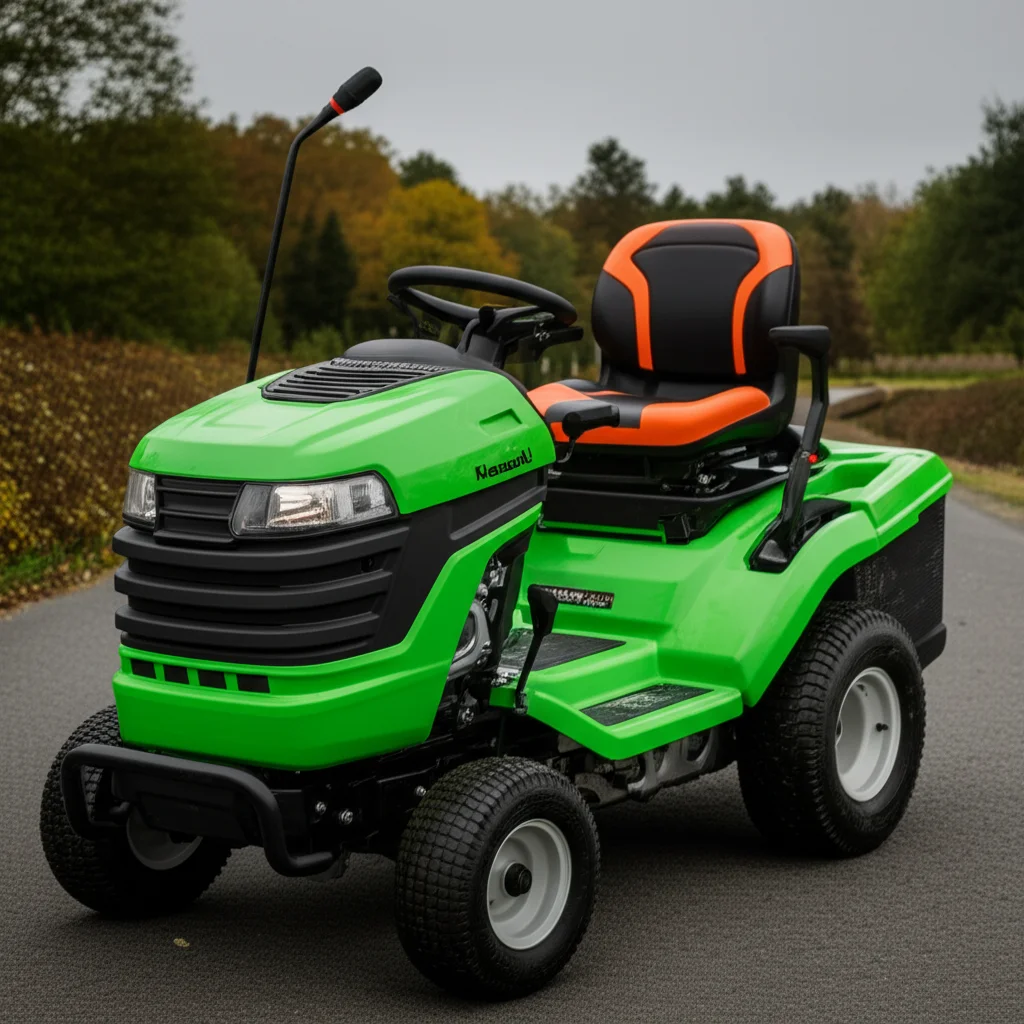· Lawn Mower Repair · 11 min read
Kawasaki Fr600v Wont Start

Kawasaki FR600V Won’t Start: Complete Troubleshooting Guide
When your Kawasaki FR600V won’t start, it can turn a simple lawn care task into a frustrating ordeal.
This reliable 18.5-horsepower engine powers many commercial and residential mowers, but like any mechanical system, it can develop starting issues over time.
Understanding the common causes and solutions can save you time, money, and the headache of dealing with a non-functional mower when you need it most.
Key Takeaways
• Fuel system problems are the most common cause of starting issues
• Electrical components like spark plugs and solenoids frequently fail
• Regular maintenance prevents most starting problems
• Step-by-step diagnosis helps identify the root cause quickly
• Professional help may be needed for complex engine problems
Quick Answer: Most Kawasaki FR600V starting problems stem from fuel delivery issues, faulty spark plugs, dead batteries, or clogged air filters. Start by checking these basic components before moving to more complex diagnostics.
Understanding Common Kawasaki FR600V Problems
The Kawasaki FR600V is generally a dependable engine, but several recurring issues can prevent it from starting properly. These problems typically fall into four main categories: fuel system malfunctions, electrical failures, air intake blockages, and mechanical wear.
Fuel-related starting problems are particularly common in engines that sit unused for extended periods. Old gasoline can gum up the carburetor, while water contamination can prevent proper combustion. The fuel system’s complexity means multiple components can fail, from the fuel pump to the carburetor jets.
Electrical issues represent another major category of starting problems. The FR600V relies on several electrical components working in harmony, including the battery, starter solenoid, ignition coil, and spark plug. When any of these components fail, the engine may crank but not fire, or it may not crank at all.
Air intake problems, while less common, can also prevent starting. A severely clogged air filter can restrict airflow to the point where the engine can’t achieve the proper air-fuel mixture needed for combustion. This issue often develops gradually, making it easy to overlook during routine maintenance.
Fuel System Troubleshooting
The fuel system is often the culprit when your Kawasaki FR600V won’t turn over or starts but immediately dies. Begin your diagnosis by examining the fuel tank for adequate fuel levels and fuel quality. Old gasoline that’s been sitting for more than 30 days can cause starting problems, especially if it contains ethanol.
Check the fuel filter for clogs or contamination. A dirty fuel filter restricts fuel flow to the carburetor, creating a lean mixture that won’t sustain combustion. Replace the fuel filter if it appears dirty or if you can’t remember when it was last changed.
The fuel pump, if equipped, should produce audible clicking sounds when the key is turned to the start position. If you don’t hear this sound, the fuel pump may have failed. Test the fuel pump by disconnecting the fuel line at the carburetor and cranking the engine. Fuel should pulse out of the line with each engine revolution.
Carburetor problems are particularly common in the FR600V. Remove the air filter and spray a small amount of starting fluid into the carburetor throat. If the engine starts briefly and then dies, the carburetor isn’t delivering fuel properly. This often indicates clogged jets or passages that require thorough cleaning.
For persistent fuel system issues, consider that Kawasaki lawn mower engines can be particularly sensitive to fuel quality and contamination, making regular fuel system maintenance crucial for reliable operation.
Electrical System Diagnosis
Electrical problems can manifest in several ways when your Kawasaki FR600V won’t start. The most obvious sign is when nothing happens when you turn the key – no clicking, no cranking, no sound at all. This typically indicates battery, solenoid, or wiring issues.
Start with the battery, checking both voltage and connection quality. The FR600V requires at least 12.6 volts for reliable starting. Clean corroded battery terminals with a wire brush and apply petroleum jelly to prevent future corrosion. Loose battery connections can cause intermittent starting problems that appear randomly.
The starter solenoid is a common failure point in the FR600V’s electrical system. You can test the solenoid by bypassing it with a screwdriver or jumper wire. If the starter engages when bypassed, replace the solenoid. A clicking sound from the solenoid without starter engagement usually indicates internal contact failure.
Spark plug condition directly affects starting performance. Remove the spark plug and inspect the electrode for wear, carbon buildup, or oil fouling. The gap should measure 0.030 inches for optimal performance. Even if the plug looks acceptable, try a new one, as weak spark plugs can cause hard starting that progressively worsens.
The ignition coil generates the high voltage needed to fire the spark plug. Test the coil by checking for spark at the plug wire. A weak or absent spark indicates coil failure. Ignition coils can fail intermittently, working when cold but failing when hot, or vice versa.
Similar electrical issues affect other Kawasaki engines, and the diagnostic approaches for FR691V starting problems often apply to the FR600V as well.
Air Intake and Filtration Issues
While less dramatic than fuel or electrical problems, air intake restrictions can prevent your Kawasaki FR600V from starting, especially in cold conditions or after extended storage. The engine requires a precise air-fuel mixture for combustion, and any significant restriction in airflow disrupts this balance.
Remove and inspect the air filter for dirt, debris, or oil saturation. A moderately dirty filter can be cleaned with compressed air, but heavily soiled filters should be replaced. Paper filters cannot be effectively cleaned once they become saturated with oil or extremely dirty.
Check the air filter housing for obstructions or damage. Small animals sometimes build nests in the housing, while broken housing components can allow unfiltered air into the engine. Ensure all housing seals are intact and properly seated.
The choke system affects air intake during starting. Manual chokes should move freely and close completely when engaged. Automatic chokes may stick in the open position, preventing rich mixture formation needed for cold starting. Clean the choke mechanism and lubricate pivot points as needed.
Inspect the intake manifold and carburetor mounting for air leaks. Loose mounting bolts or damaged gaskets can create vacuum leaks that lean out the fuel mixture beyond the combustible range. A simple test involves spraying carburetor cleaner around gasket areas while the engine is running; rpm changes indicate air leaks.
Carburetor Cleaning and Maintenance
Carburetor problems represent one of the most common reasons why a Kawasaki FR600V won’t start, particularly after periods of storage. Modern gasoline with ethanol content is especially problematic, as it can gum up carburetor passages and corrode internal components.
Begin carburetor maintenance by removing the bowl and inspecting for fuel contamination, water, or debris. Clean the bowl thoroughly with carburetor cleaner and inspect the main jet for clogs. Use compressed air to blow through all passages, never use wire or drill bits that might damage precisely sized orifices.
The float and needle valve control fuel level in the carburetor bowl. Check the float for fuel saturation or damage, and ensure the needle valve seats properly. A stuck needle valve can flood the engine, while a worn needle valve can cause fuel starvation.
Disassemble the carburetor completely for thorough cleaning if the engine has been stored with fuel in the system. Soak all metal parts in carburetor cleaner for several hours, then use compressed air to clear all passages. Replace any rubber components like O-rings and gaskets, as they often deteriorate when exposed to ethanol-blended fuels.
After reassembly, adjust the carburetor according to manufacturer specifications. The idle mixture screw typically requires 1.5 turns out from the lightly seated position as a starting point. Fine-tune the mixture based on engine performance once it’s running.
Many carburetor issues mirror those found in other small engines, and techniques for Honda GCV160 starting problems can often be adapted for Kawasaki engines.
Starting Procedure and Safety Checks
Proper starting procedure is crucial for the Kawasaki FR600V, and many apparent starting problems actually result from incorrect operation rather than mechanical failure. Understanding the correct sequence can prevent damage and ensure reliable starts.
Before attempting to start the engine, perform these safety checks: ensure the parking brake is engaged, the blade engagement lever is disengaged, and the operator is seated properly. Many mowers have safety interlocks that prevent starting if these conditions aren’t met.
Turn the fuel valve to the “on” position if equipped. Some FR600V installations include a manual fuel shutoff valve that must be opened before starting. Check that the choke is in the correct position – typically closed for cold starts and open for warm restarts.
Prime the engine if equipped with a primer bulb. Press the bulb 3-5 times for cold starts, or according to manufacturer specifications. Over-priming can flood the engine, while under-priming may prevent initial combustion.
Turn the ignition key to start and hold for no more than 10 seconds at a time. Allow 30 seconds between starting attempts to prevent starter motor overheating. If the engine doesn’t start after three attempts, investigate potential problems rather than continuing to crank.
Once the engine starts, allow it to warm up at idle speed before engaging the cutting blades or driving off. Cold engines need time to reach operating temperature for optimal performance and longevity.
Professional Diagnosis and Repair
While many Kawasaki FR600V starting problems can be resolved with basic troubleshooting, some issues require professional diagnosis and repair. Recognizing when to seek professional help can prevent further damage and costly repairs.
Consider professional service if you’ve exhausted basic troubleshooting steps without success. Compression testing, for example, requires specialized equipment and expertise to perform accurately. Low compression can indicate worn piston rings, damaged valves, or blown head gaskets – all problems requiring professional repair.
Internal engine problems like timing gear wear or crankshaft issues produce symptoms that mimic simpler problems but require extensive disassembly to repair. Professional technicians have the tools and experience to differentiate between simple fixes and major repairs.
Electrical system problems beyond basic component replacement often require diagnostic equipment to identify. Professional technicians can test charging systems, perform load tests on batteries, and diagnose complex wiring problems that might not be obvious during visual inspection.
Warranty considerations may also dictate professional service. If your FR600V is still under warranty, attempting repairs yourself might void coverage. Professional service ensures warranty compliance while providing expert diagnosis.
Document all symptoms and attempted repairs before visiting a service center. This information helps technicians diagnose problems more efficiently and can reduce diagnostic fees. Include details about when the problem started, under what conditions it occurs, and what you’ve already tried.
For engines that turn over but won’t start, the troubleshooting approach for Kawasaki lawn engines that turn over but won’t start provides additional diagnostic strategies.
Frequently Asked Questions
What is the most common reason a Kawasaki FR600V won’t start? Fuel system problems, particularly carburetor issues caused by old gasoline or ethanol damage, are the most frequent causes of starting problems. Regular fuel system maintenance and using fresh gasoline can prevent most of these issues.
How do I know if my Kawasaki FR600V starter solenoid is bad? A clicking sound when turning the key without starter engagement typically indicates solenoid failure. You can test by bypassing the solenoid with a screwdriver or jumper wire. If the starter works when bypassed, replace the solenoid.
What type of oil should I use in my Kawasaki FR600V? Use SAE 10W-40 oil for most operating conditions, or 20W-50 for high-temperature operation. The oil capacity is approximately 2 quarts with filter change. Always check the owner’s manual for specific recommendations based on operating conditions.
How many horsepower does a Kawasaki FR600V produce? The Kawasaki FR600V produces 18.5 horsepower at 3,600 RPM. This makes it suitable for mid-size residential and light commercial mowing applications requiring moderate power output.
Why won’t my mower start after sitting all winter? Winter storage often causes fuel system problems due to gasoline degradation and carburetor varnishing. Water contamination from condensation can also prevent starting. Drain old fuel, clean the carburetor, and replace the spark plug before attempting to start.
Can I clean my Kawasaki FR600V carburetor myself? Basic carburetor cleaning is within most DIY capabilities, but complete rebuilding requires mechanical skills and proper tools. Start with bowl cleaning and jet clearing. If problems persist, consider professional service to avoid damage.
What should I do if my engine cranks but won’t fire? Check for spark at the plug wire, verify fuel delivery to the carburetor, and ensure proper air filter condition. These three elements – spark, fuel, and air – are essential for combustion. Missing any one prevents starting.
Final Words
Diagnosing why your Kawasaki FR600V won’t start requires systematic troubleshooting of fuel, electrical, and air systems. Most starting problems stem from preventable maintenance issues like old fuel, dirty air filters, or worn spark plugs.
Regular maintenance prevents most starting problems and ensures reliable operation when you need your mower most.
If basic troubleshooting doesn’t resolve the issue, don’t hesitate to consult a professional technician who can perform advanced diagnostics and repairs.
Remember that proper winter storage and quality fuel can prevent many starting problems before they occur. Take action today to diagnose your starting problem using these proven troubleshooting steps.


